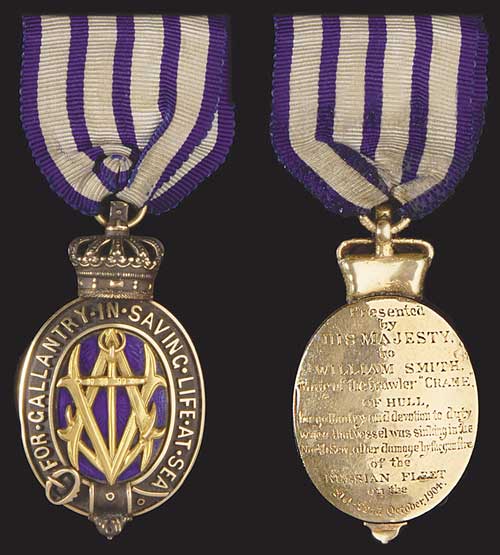
Auction: 9024 - The Property of a Gentleman Orders, Decorations and Campaign Medals
Lot: 690
The Scarce Albert Medal 1st Class, For Gallantry in Saving Life at Sea to William Smith, Mate of the Trawler Crane, Which Was Shelled and Sunk By the Russian Baltic Fleet in the Infamous ´Dogger Bank Incident´, 21-22.10.1904, When 30 British Fishing Vessels Were Mistaken For Japanese War Ships; Smith, Upon Discovering that the Skipper Had Been Killed During the Shelling, Despite Being Wounded Himself, Took Command of the Doomed Vessel, Evacuated the Dead and Wounded, and Was the Last Man to Leave the Sinking Ship Albert Medal, 1st Class, For Gallantry in Saving Life at Sea, gold and enamel, the reverse officially engraved, ´Presented by His Majesty to William Smith, Mate of the Trawler "Crane", of Hull, for gallantry and devotion to duty when that vessel was sinking in the North Sea, after damage by the gunfire of the Russian Fleet on the 21st-22nd October, 1904.´, nearly extremely fine Estimate £ 8,000-10,000 A.M. London Gazette 16.5.1905 William Smith, Mate, joint citation with Arthur Rea, Second Engineer (both Albert Medals First Class), both of the Trawler Crane; and to Charles Beer, Mate and Harry Smirk, Chief Engineer; Edwin Costello, Boatswain (all Albert Medals Second Class), all of the Trawler Gull, ´´The steam trawler Crane was so badly damaged by the gun fire of the Russian Baltic Fleet in the North Sea on the night of the 21st October and the morning of the 22nd October last, that she began to sink. The skipper and the third hand of the vessel had been killed, and, with one exception, the surviving members of the crew were all wounded. The mate, William Smith, was severely wounded while on his way to assist the injured boatswain, and when he found that the skipper was killed, took charge of the sinking vessel. He subsequently signalled for assistance, and when the boat from the steam trawler Gull arrived he assisted in getting the wounded and the bodies of the dead into the boat, and was the last to leave the Crane just before she sank. As the Chief Engineer had been wounded and rendered insensible soon after the firing began, the Second Engineer, Arthur Rea (22 years of age) took charge of the engines, and, although the lights had been extinguished, he went into the stokehold to discover the cause of a loud report and an escape of steam. He was knocked down by a shot on his way but went on, and finding the stokehold more than a foot deep in water and steam blowing from the engine side, looked at the gauge glass and pumping additional cold water into the boiler partially drew the fires with the object of averting an explosion. He also set the pumps of the vessel working, and after reporting that the vessel was sinking, went a second time into the darkened engine room and stopped the engines. Although wounded he did not stop working till he left the ship. In answer to signals of distress from the Crane, Charles Beer, Mate, Harry Smirk, Chief Engineer, and Edwin Costello, Boatswain, of the steam trawler Gull, after the firing, which had been heavy and sustained, went in a boat to the Crane, and succeeded with great difficulty in rescuing the wounded from the rapidly sinking vessel, and in bringing away the dead bodies of those who had been killed.´´ The ´´Dogger Bank Incident´´ On the night of the 21st October 1904 the Russian Baltic Fleet was enroute for Vladivostock. Russia was at war with Japan and the Baltic Fleet was ill at ease as it progressed through the North Sea. The Russians had received incorrect reports that Japanese torpedo boats and submarines were present in their immediate vicinity. The disaster that ensued started earlier in the evening when the drunken Captain of the supply ship Kamtchatka, which was the last in the Russian line, mistook a passing Swedish vessel for a Japanese torpedo boat. He put the nerves of the fleet further on edge by reporting that he was under attack. This was eventually discredited although to a large extent the damage had already been done. A few hours later Russian duty officers sighted the lights of approximately 30 vessels. The lights belonged to a harmless fleet of British fishing vessels including the trawlers Crane and Gull. The officers of the watch mis-interpreted their signals and incorrectly classified them as Japanese torpedo boats. As a consequence the Russian Fleet opened fire upon the fishing vessels. The casualties were three British civilians killed and several wounded. Although the casualties were fortunately a lot lower than they could have been considering the fire power available the attack did cause a major diplomatic incident between the British and Russian Governments. Outrage was expressed in the newspapers of the time with the Russians labelled as ´´pirates´´. Battleships of the Home Fleet were prepared for war, whilst cruiser squadrons shadowed the Russian Fleet as it made its way through the Bay of Biscay. The Russian Government eventually gave into diplomatic pressure and agreed to investigate the incident internally, with the aggrieved British fisherman receiving £66,000 in compensation. In 1906 the Fisherman´´s Memorial was unveiled in Hull in honour of the death of the three British sailors. All of the men named in the citation, with the exception of Edwin Costello, were presented with their medals by the King at Buckingham Palace, 13.5.1905. Provenance: Sotheby June 1971
Sold for
£15,000




